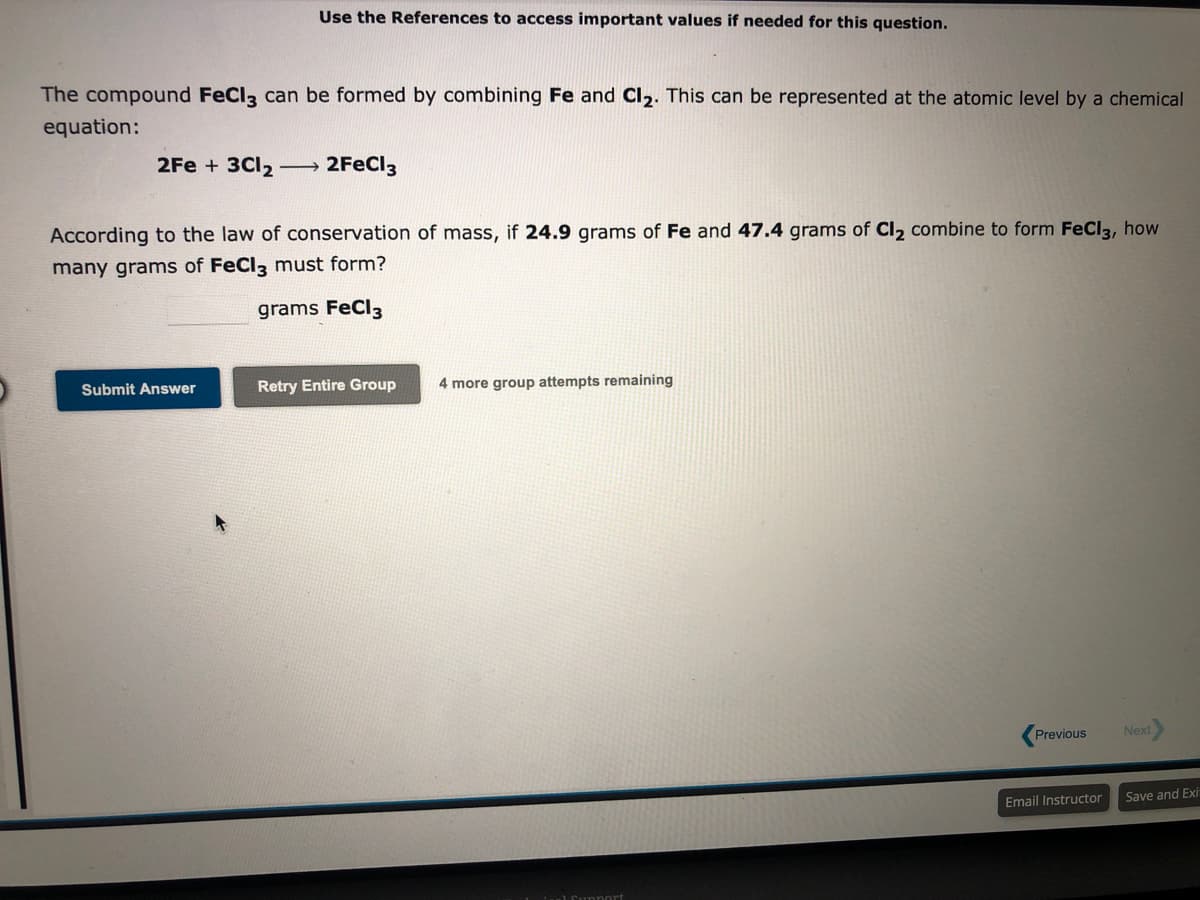Use the References to access important values if needed for this question. The compound H₂O₂ can be decomposed to form H₂O and O2. This can be represented at the atomic level by a chemical equation: 2H₂O2 2H₂O + 02 According to the law of conservation of mass, if 32.7 grams of H₂O₂ decomposes and 17.3 grams of H₂O is formed, how many grams of O₂ must simultaneously be formed? grams 0₂
Use the References to access important values if needed for this question. The compound H₂O₂ can be decomposed to form H₂O and O2. This can be represented at the atomic level by a chemical equation: 2H₂O2 2H₂O + 02 According to the law of conservation of mass, if 32.7 grams of H₂O₂ decomposes and 17.3 grams of H₂O is formed, how many grams of O₂ must simultaneously be formed? grams 0₂
Chemistry for Engineering Students
4th Edition
ISBN:9781337398909
Author:Lawrence S. Brown, Tom Holme
Publisher:Lawrence S. Brown, Tom Holme
Chapter3: Molecules, Moles, And Chemical Equations
Section: Chapter Questions
Problem 3.83PAE: 3.83 For the reaction of nitrogen, N2, and hydrogen, H2, to form ammonia, NH3, a student is...
Related questions
Question
Please help
![[Review Topics]
[References]
Use the References to access important values if needed for this question.
The compound H₂O₂ can be decomposed to form H₂O and O₂. This can be represented at the atomic level by a chemical
equation:
2H₂O2 → 2H₂O + 0₂
According to the law of conservation of mass, if 32.7 grams of H₂O₂ decomposes and 17.3 grams of H₂O is formed,
how many grams of O₂ must simultaneously be formed?
grams 0₂
Submit Answer
Retry Entire Group 4 more group attempts remaining
Cengage Learning | Cengage Technical Support
Previous
Email Instructor
Next
Save and Exit](/v2/_next/image?url=https%3A%2F%2Fcontent.bartleby.com%2Fqna-images%2Fquestion%2Ff983a246-f2a3-4107-826c-aaa4911ccda6%2F468025f7-89b8-4d8b-b6d9-322cb1955932%2Flibrvf_processed.jpeg&w=3840&q=75)
Transcribed Image Text:[Review Topics]
[References]
Use the References to access important values if needed for this question.
The compound H₂O₂ can be decomposed to form H₂O and O₂. This can be represented at the atomic level by a chemical
equation:
2H₂O2 → 2H₂O + 0₂
According to the law of conservation of mass, if 32.7 grams of H₂O₂ decomposes and 17.3 grams of H₂O is formed,
how many grams of O₂ must simultaneously be formed?
grams 0₂
Submit Answer
Retry Entire Group 4 more group attempts remaining
Cengage Learning | Cengage Technical Support
Previous
Email Instructor
Next
Save and Exit

Transcribed Image Text:Use the References to access important values if needed for this question.
The compound FeCl3 can be formed by combining Fe and Cl₂. This can be represented at the atomic level by a chemical
equation:
2Fe + 3Cl2 → 2FeCl3
According to the law of conservation of mass, if 24.9 grams of Fe and 47.4 grams of Cl₂ combine to form FeCl3, how
many grams of FeCl3 must form?
grams FeCl3
Submit Answer
Retry Entire Group
4 more group attempts remaining
Previous
Email Instructor
Next>
Save and Exit
Expert Solution
This question has been solved!
Explore an expertly crafted, step-by-step solution for a thorough understanding of key concepts.
This is a popular solution!
Trending now
This is a popular solution!
Step by step
Solved in 3 steps

Knowledge Booster
Learn more about
Need a deep-dive on the concept behind this application? Look no further. Learn more about this topic, chemistry and related others by exploring similar questions and additional content below.Recommended textbooks for you

Chemistry for Engineering Students
Chemistry
ISBN:
9781337398909
Author:
Lawrence S. Brown, Tom Holme
Publisher:
Cengage Learning

Chemistry
Chemistry
ISBN:
9781305957404
Author:
Steven S. Zumdahl, Susan A. Zumdahl, Donald J. DeCoste
Publisher:
Cengage Learning


Chemistry for Engineering Students
Chemistry
ISBN:
9781337398909
Author:
Lawrence S. Brown, Tom Holme
Publisher:
Cengage Learning

Chemistry
Chemistry
ISBN:
9781305957404
Author:
Steven S. Zumdahl, Susan A. Zumdahl, Donald J. DeCoste
Publisher:
Cengage Learning


Chemistry: An Atoms First Approach
Chemistry
ISBN:
9781305079243
Author:
Steven S. Zumdahl, Susan A. Zumdahl
Publisher:
Cengage Learning

Chemistry: Principles and Reactions
Chemistry
ISBN:
9781305079373
Author:
William L. Masterton, Cecile N. Hurley
Publisher:
Cengage Learning